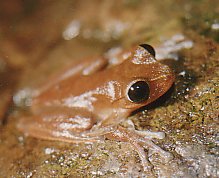
Nyctimystes is a genus of tree frogs in the subfamily Pelodryadinae of the family Hylidae. They are principally Papuan species, but also inhabit islands in the Moluccas. All species in this genus have one distinct feature that separates them from other species in the family, the lower eyelid is marked with pattern of lines, veins, or dots. This feature presumably acts as camouflage when the frogs are at rest during the day.

The white-lipped tree frog is a species of frog in the subfamily Pelodryadinae. It is the world's largest tree frog and is found in Australia. Other common names include the New Guinea treefrog, giant tree frog, and Australian giant treefrog.
Nyctimystes daymani, also known as the Dayman big-eyed treefrog, is a species of frog in the subfamily Pelodryadinae. It is endemic to Papua New Guinea and known from its type locality, Mount Dayman in the Milne Bay Province, easternmost mainland New Guinea. Records from further west are uncertain.
Nyctimystes fluviatilis, also known as the Indonesian big-eyed tree frog, is a species of frog in the subfamily Pelodryadinae of the family Hylidae. It is endemic to New Guinea and is known from Idenburg River and Wapoga River in Papua province, Indonesia, and from the Torricelli Mountains in the East Sepik Province and Kavorabip in the Western Province, both in the western Papua New Guinea.
Nyctimystes gularis, the Mondo big-eyed tree frog, is a species of frog in the subfamily Pelodryadinae, endemic to Papua New Guinea. Its natural habitats are subtropical or tropical moist montane forests and rivers.
Nyctimystes kubori is a species of frog in the subfamily Pelodryadinae of the family Hylidae. It is endemic to Papua New Guinea and is widespread in the New Guinea Highlands between 141°E and 147°E and in the mountains of the Huon Peninsula. The specific name kubori refers to its type locality in the Kubor Mountains. Common name sandy big-eyed treefrog has been coined for this species.
Nyctimystes narinosus, the common big-eyed treefrog, is a species of frog in the subfamily Pelodryadinae of the family Hylidae. It is endemic to New Guinea and occurs in the Wahgi-Sepik Dividing Range and the Schrader Mountains, on both sides of the border between Papua (Indonesia) and Papua New Guinea. There is, however, some uncertainty about the western limit of this species. Despite its vernacular name, Nyctimystes narinosus is not a common species.
Nyctimystes persimilis, also known as the Milne big-eyed treefrog, is a species of frog in the subfamily Pelodryadinae of the family Hylidae. It is endemic to Papua New Guinea and known from Mount Dayman and Mount Simpson in the Owen Stanley Range.
Nyctimystes trachydermis, also known as the Morobe big-eyed treefrog, is a species of frog in the subfamily Pelodryadinae of the family Hylidae. It is endemic to Papua New Guinea and occurs in the mountains of southern eastern New Guinea. Its type locality is Gapaia Creek, at 1,280 m (4,200 ft) asl between Garaina and Saureli, in the Morobe Province. The specific name trachydermis means "rough skinned", derived from the Greek words trachys and derma.
Nyctimystes tyleri is a species of frog in the subfamily Pelodryadinae of the family Hylidae. It is endemic to Papua New Guinea and only known from its type locality, Gapaia Creek, between Garaina and Saureli, in the Morobe Province. The specific name honours Michael J. Tyler, an Australian herpetologist, "in recognition of his notable contributions to the systematics of Australo-papuan frogs." Common name Tyler's big-eyed treefrog has been coined for this species.

Leptopelis calcaratus is a species of frog in the family Arthroleptidae. It is found in southeastern Nigeria, Cameroon, the southwestern Central African Republic, Equatorial Guinea, Gabon, the Republic of the Congo, and the Democratic Republic of the Congo. Common name Efulen forest treefrog has been coined for it.
Nyctimystes eucavatus is a species of tree frog in the family Hylidae. It is endemic to eastern Papua New Guinea. Scientists have observed it between 800 and 1200 meters above sea level in the eastern mountains.
Nyctimystes sauroni is a species of tree frog and an endemic to Papua New Guinea Scientifically, it is in the subfamily Pelodryadinae. It is Scientists know it solely from the Kikori Integrate Conservation and Development Project area.
Nyctimystes traunae is a species of tree frog in the subfamily Pelodryadinae, endemic to Papua New Guinea. It lives on mountains in the centre of the island in the Western Highlands Province. Scientists have seen it about 800 meters above sea level.
Nyctimystes pallidofemora is a species of tree frog in the subfamily Pelodryadinae, endemic to Papua New Guinea. Scientists disagree about whether this frog is best placed in the genus Nyctimystes or the genus Litoria.
Nyctimystes bivocalis is a species of frog in the subfamily Pelodryadinae, endemic to New Guinea. It has been observed in the Cloudy Mountains and part of the Owen Stanley Mountains in Milne Bay Province. The adult male frog measures 38.5 to 49.2 mm long in snout-vent length and it is gray-brown in color. The adult female measures 42.2 to 55.7 mm long and is orange-brown in color.
Nyctimystes cryptochrysos is a species of tree frog in the subfamily Pelodryadinae, endemic to Papua New Guinea. It lives on Fergusson Island between 900 and 1500 meters above sea level. Scientists suspect it may also live in the D'Entrecasteaux Islands.
Nyctimystes nullicedens is a species of tree frog in the subfamily Pelodryadinae. It is endemic to Papua New Guinea and has been found on the south-western side of Mount Obree, at 550 meters above sea level.
Nyctimystes myolae is a species of tree frog in the subfamily Pelodryadinae, endemic to Papua New Guinea. Scientists observed this frog near the village of Myola village, at 2000 meters above sea level.
Nyctimystes latratus is a species of tree frog in the subfamily Pelodryadinae endemic to Papua New Guinea. Scientists have seen it between 500 and 1200 meters above sea level on Mount Dayman and near the Bai-u River.



